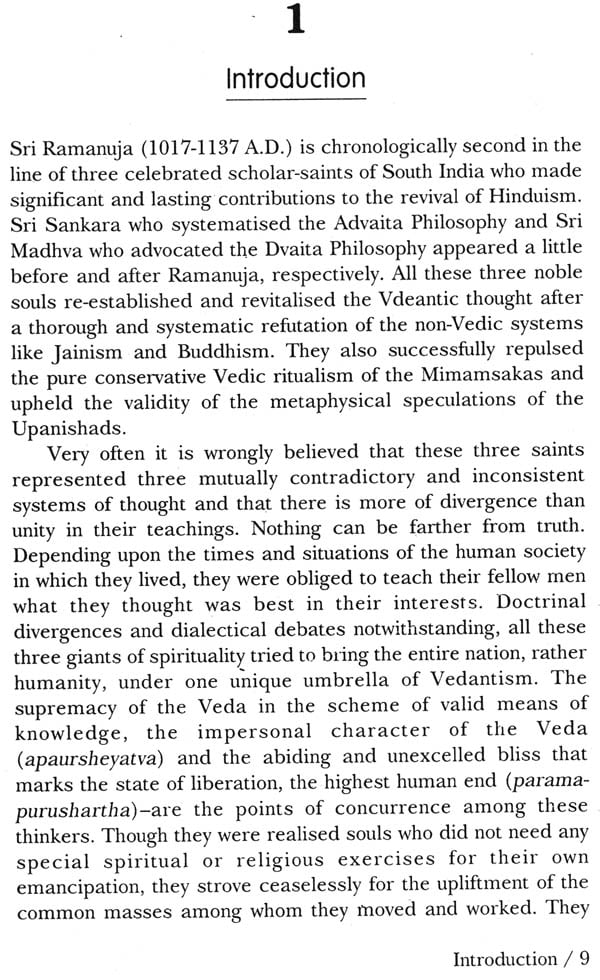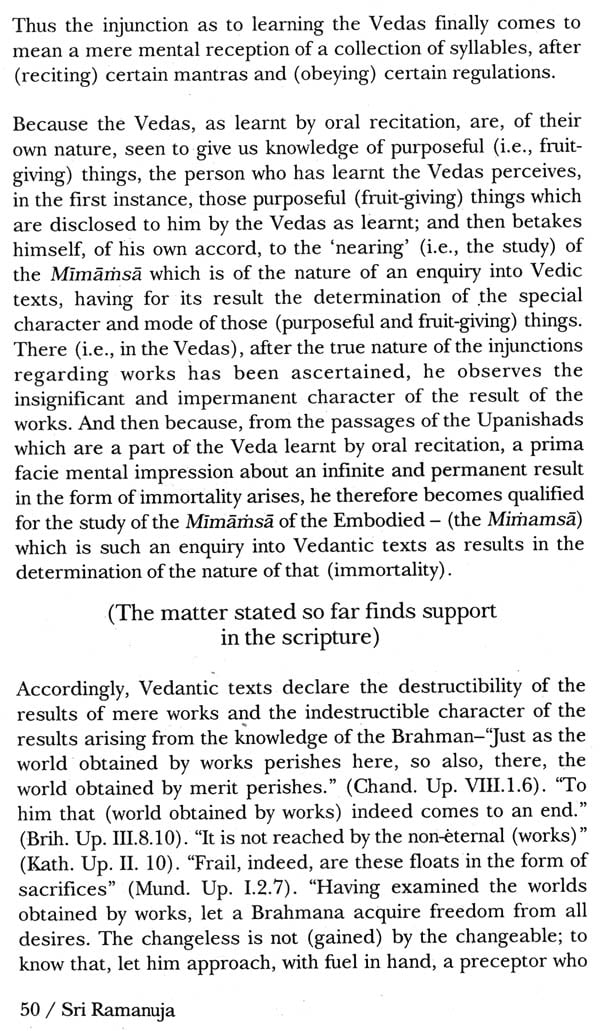
Sri Ramanuja ( Makers of Indian Literature )
Book Specification
| Item Code: | NAU389 |
| Author: | M. Narasimhachary |
| Publisher: | Sahithya Akademi, Chennai |
| Language: | English |
| Edition: | 2018 |
| ISBN: | 9788126018338 |
| Pages: | 52 |
| Cover: | PAPERBACK |
| Other Details | 8.50 X 5.50 inch |
| Weight | 86 gm |
Book Description
Sri Ramanuja
Sri Ramanuja (1017-1137) was the great systematiser of what is now popularly known as Visistadvaita Philosophy. He differed from Sankara, Bhaskara and Yadava Prakasa in his interpretation of the Prasthana Traya. According to him, the Supreme Brahman is Lord Sriman Narayana or Srinivasa, Brahman is the 'soul' of which the universe of men and matter constitutes the 'body'. Bhakti (loving devotion) and whole-hearted surrender (prapatti) are the alternative means of liberation. To him goes the credit of going through the Bodhayana Vritti on the Brahmasutra on the basis of which he composed his celebrated commentary, the Sribhasya. The present monograph is the moving account of the life and works of Sri Ramanuja. His philosophy and especially, his concept of bhakti and prapatti inspired several later Vaishnava thinkers like Nimbarka, Madhva, Vallabha, Ramananda, Srikrishna Chaitanya and Swami Narayana in formulating and shaping their own systems of thought.
M. Narasimhachary
M. Narasimhachary (b.1939-2013) writer of the present monograph, was an erudite scholar of Vedanta with specialization in Visistadvaita was the founder Professor and Head Deptt. of Vaishnavism, University of Madras. He was awarded Ph.D for his thesis ‘Contribution of Sri Yamunacharya to Visistadvaita'. He taught Sanskrit and Indian Philosophy at Kualalumpur (1982-84). Visiting Professor in USA and Visiting Academic at the Oxford University, U.K., Dr. Chary has authored several research articles and books. Receipient of titles such as Asukavisekhara, Sastrakaviratna, Srivaishnava Ratna and Desika Bhavajna. Prof. Narasimhachary received the Certificate of Honour for Proficiency in Sanskrit from the President of India for the year 2004.
Sri Ramanuja (1017-1137) was a great saint, scholar, visionary and social reformer. His view of the universe as the body of the Lord of which He is the soul, summarizes his vision of life. Every living being, scholarly or unlettered, of a higher origin or a lower origin, is part of the divine scheme. Nobody is outside the purview of God’s grace. His position in the world of Vedanta is unique. Though chronologically he came next to Sankara, the impression he left on the subsequent thinkers and writers is immense. Acharyas like Nimbarka, Vallabha, Ramananda and Swami Naryana drew their inspiration from the concepts of Bhakti and Prapatti popularized by Ramanuja.. Even among the Advaitins, Madhusudana Saraswati must have been profoundly influenced by the Bhakti tradition since he was an ardent devotee of Sri Krishna.
Given in the following pages is a brief but exhaustive account of the life and work of this great teacher of Vedanta whom Swami Vivekananda acclaimed as a great benefactor of humanity. According to Sri Ramanuja, the Supreme Brahman is Lord Sriman Narayana or Srinivasa. Brahman is the ‘soul’ of which the universe of men and matter constitutes the ‘body’. Bhakti (loving devotion) and whole-hearted or total surrender (prapatti) are the alternative means of liberation. He wrote nine works in Sanskrit highlighting these truths. To him goes the credit going through the Bodhayana Vritti on the Brahmasutra during his visit to Kashmir on the basis of which he composed his celebrated commentary, the Sribhasya.
Ramanuja, above all the achievements in the field of religion and philosophy, was a great social reformer. He allowed the so-called ‘fifth community’ to enter the temple of Lord Tirunarayana at Melkote (Karnataka). To him also goes the credit of explaining the meaning of a secret mantra to many, against the wishes of his own preceptor since he believed that instead of his own self, many others should become eligible for liberation. Ramanuja was a great visionary. He saw that to attain liberation, Bhakti is easier to practice by the ordinary masses than Jnana which was propounded by Sankara and his followers. He inherited a rich tradition—Sanskrit Vedas, the Tamil Veda (called the Divya Prabandha) of the Srivaishnava mystic saints Azhvars, the Agama literature and the Puranas. All great ideas flowed in on him from these sources and he responded to all of them with a sympathetic heart. The result is the monumental philosophy called Visistadvaita. In his interpretation, every scriptural text finds an appropriate place.
Ramanuja’s long and eventful life spanning 120 years is marked by several achievements. The tradition he has left is called the Sri Sampradaya since in his Gadyas (poetic prose passages) he conceived Goddess Sri or Lakshmi as the benign mother presenting all the erring humans before the Lord and making them eligible for His forgiveness and Grace. He paid glowing tributes to his "large-heartedness" and to his catholicity in admitting the downtrodden to his fold offering them solace and bliss. For sometime in the East and the West the term ‘Vedanta’ stood for Advaita only. Scholars like Prof. P.N. Srinivasachari and Dr. K.C. Varadachari, through their works countered this trend to some extent. Now, there is a greater awareness of the contributions of Ramanuja to the world of scholars. The present writer has also in recent years, contributed to this trend by giving a series of lectures at the Oxford University (UK) on the salient features of Sri Ramanuja’s philosophy.








